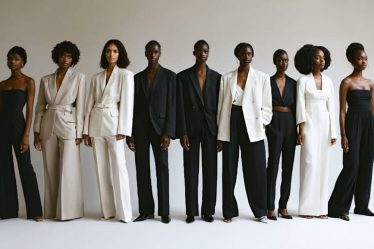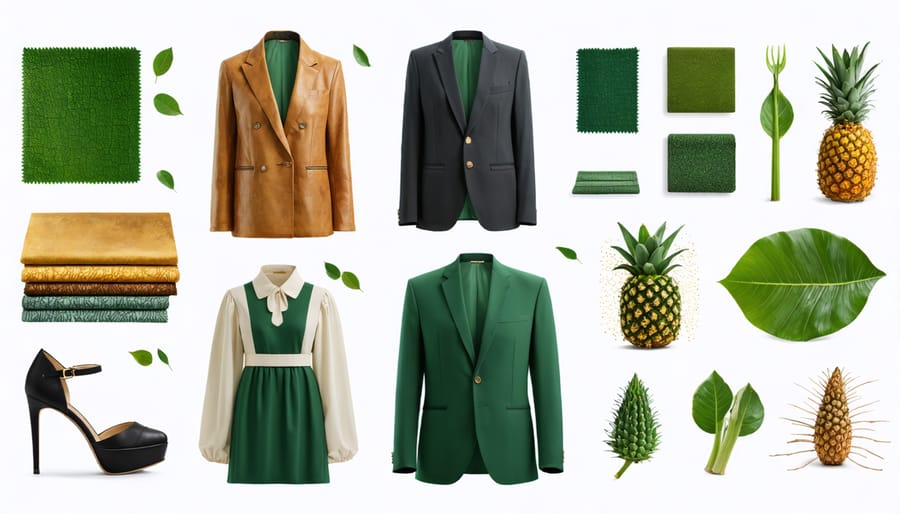
Transform your wardrobe into sustainable fashion that lasts without sacrificing style or breaking the bank. Today’s eco-conscious brands are reimagining fashion with innovative materials, ethical production methods, and timeless designs that prove sustainability can be seriously stylish. From Reformation’s dreamy dresses crafted from deadstock fabrics to Everlane’s transparent pricing and production practices, conscious fashion has evolved far beyond basic organic cotton tees. Whether you’re just starting your sustainable style journey or looking to expand your earth-friendly wardrobe, these trending brands are proving that doing good and looking good go hand in hand. They’re creating everything from work-ready basics to statement pieces that will have friends asking “Where did you get that?” – all while prioritizing our planet’s wellbeing.
What Makes a Fashion Brand Truly Sustainable?
Material Sourcing and Production Methods
Today’s sustainable fashion brands are revolutionizing the industry with innovative eco-friendly materials and ethical production practices. Many leading brands use organic cotton grown without harmful pesticides, recycled polyester made from plastic bottles, and regenerative wool that actually helps restore grasslands. I’ve noticed a growing trend toward plant-based alternatives like Tencel (made from wood pulp) and innovative fabrics created from pineapple leaves and mushroom leather.
What’s equally exciting is how these brands approach production. Most partner with small-scale artisan workshops or family-owned factories that provide fair wages and safe working conditions. Many implement zero-waste cutting techniques and use solar-powered facilities. Some even operate on a made-to-order basis to prevent overproduction – something I particularly appreciate as it ensures every piece serves a purpose.
The transparency around sourcing and production methods has become a cornerstone of sustainable fashion, with brands regularly sharing their factory lists and material certifications with customers.
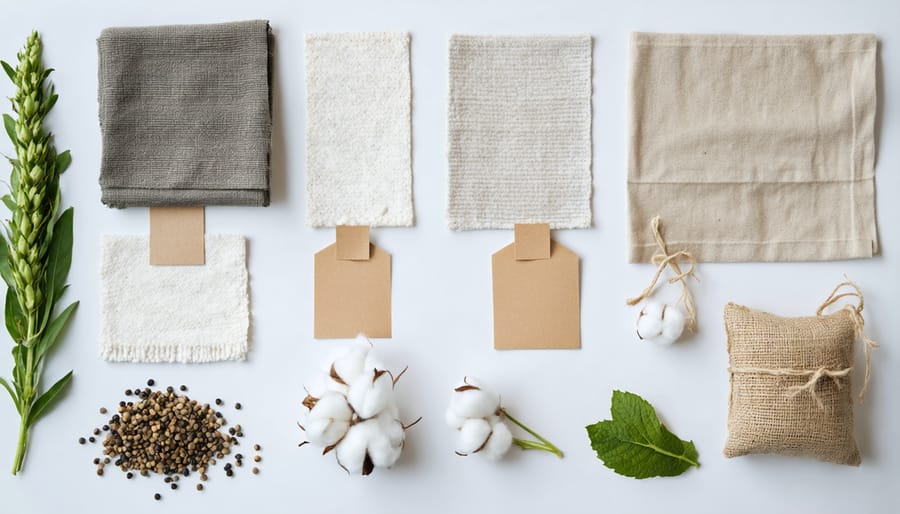
Transparency and Fair Labor Practices
In today’s fashion landscape, transparency isn’t just a buzzword – it’s a necessity. The most trusted sustainable brands are taking remarkable steps to ensure their supply chains are ethical and visible to consumers. Many provide detailed information about their factory locations, working conditions, and wage policies right on their websites. I’ve noticed a growing trend where brands are sharing stories about their artisans and craftspeople, helping us connect with the real people behind our clothes.
Some standout brands even offer virtual factory tours and publish annual impact reports, detailing everything from worker satisfaction rates to environmental initiatives. What I particularly love is how some companies are using QR codes on their garments, allowing you to trace your piece’s journey from raw material to finished product. This level of transparency helps us make informed choices and ensures we’re supporting brands that truly care about their workers’ wellbeing, from fair wages to safe working conditions and reasonable hours.
Stylish Sustainable Brands That Don’t Compromise on Design
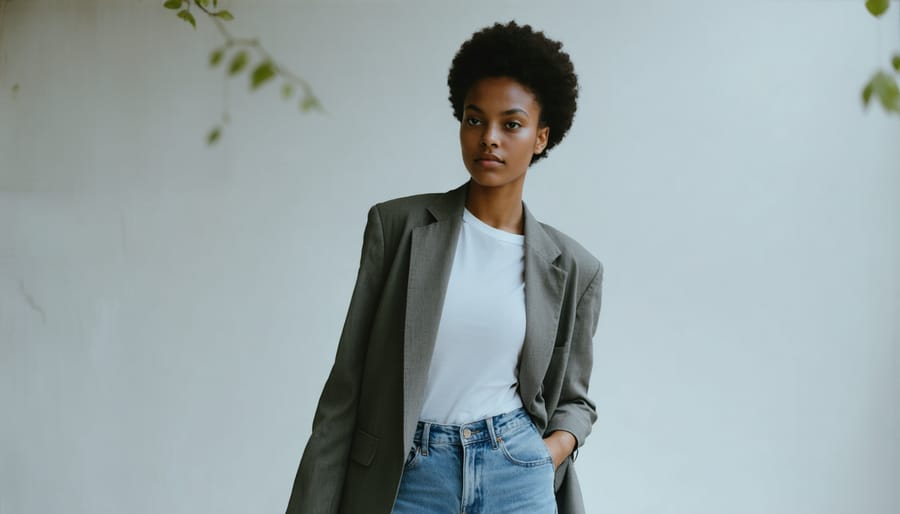
Everyday Essentials Brands
When it comes to building a sustainable wardrobe, the foundation lies in high-quality basics that stand the test of time. Organic Basics has revolutionized everyday essentials with their incredibly soft organic cotton underwear, classic tees, and versatile activewear. Their transparent production methods and commitment to reducing water usage make them a standout choice for conscious consumers.
For those seeking the perfect white tee or timeless denim, Outerknown delivers with their range of ethically-made staples. Founded by pro surfer Kelly Slater, the brand uses innovative materials like recycled fishing nets and organic cotton to create pieces that feel as good as they look.
Alternative Apparel has mastered the art of sustainable comfort with their buttery-soft basics. From cozy sweatshirts to everyday tees, each piece is crafted using organic and recycled materials, with low-impact dyes that minimize environmental impact.
Don’t overlook Kotn, a certified B-Corp that works directly with Egyptian cotton farmers. Their minimalist aesthetic and premium quality basics have earned them a loyal following. I personally love their fitted turtlenecks, which have become my go-to for both work and weekend wear.
These brands prove that sustainable basics don’t have to be boring or break the bank. By investing in well-made essentials from these conscious companies, you’re building a wardrobe that’s kind to both the planet and your personal style.
Statement Piece Designers
For those who love to make a bold fashion statement while staying true to their eco-conscious values, several designers are creating extraordinary sustainable pieces that demand attention. I recently discovered House of Sunny, a brand that’s revolutionizing sustainable statement wear with their vibrant prints and innovative use of recycled materials. Their signature wavy-knit cardigans have become Instagram sensations, proving that eco-friendly can be eye-catching.
Another game-changer is Reformation’s occasion wear line, where vintage-inspired dresses meet modern sustainability. Their limited-edition collections feature deadstock fabrics transformed into show-stopping pieces that feel both timeless and contemporary. I’ve worn their pieces to countless events, and they never fail to spark conversations about sustainable fashion.
Marine Serre has earned cult status for turning recycled materials into high-fashion treasures. Their iconic crescent moon print pieces, crafted from upcycled materials, have graced both streetwear enthusiasts and celebrities alike. Meanwhile, Zero Waste Daniel creates one-of-a-kind garments from pre-consumer waste, turning potential landfill materials into wearable art.
For accessories that make a statement, Rothy’s limited-edition collections transform plastic bottles into stunning bags and shoes that look anything but recycled. Each piece tells a story of innovation and conscious design, proving that sustainability doesn’t mean sacrificing style or individuality.
Affordable Eco-Fashion Options
Gone are the days when sustainable fashion meant breaking the bank. As someone who’s been on the journey to build an eco-conscious wardrobe without maxing out my credit card, I’m excited to share some wallet-friendly options that don’t compromise on style or sustainability.
Thrift shopping has become increasingly trendy, with platforms like ThredUp and Poshmark offering pre-loved designer pieces at fraction of their original prices. I recently scored a like-new sustainable denim jacket for just $30 – a steal compared to its $150 retail price!
Several emerging brands are making sustainability accessible. For instance, Organic Basics offers high-quality essentials starting at $20, while People Tree frequently runs sales on their fair-trade collections. H&M’s Conscious Collection and UNIQLO’s sustainable lines provide budget-friendly entry points into eco-fashion, with many pieces under $40.
Don’t overlook local clothing swaps and vintage stores – they’re treasure troves for unique, sustainable finds. Many of my favorite wardrobe pieces came from community swap events, where I exchanged clothes I no longer wore for fresh styles.
Remember, building a sustainable wardrobe doesn’t happen overnight. Start small by replacing worn-out items with eco-friendly alternatives, and keep an eye out for seasonal sales from sustainable brands. By shopping smartly and staying patient, you can create a stylish, sustainable wardrobe without overspending.
How to Build a Sustainable Wardrobe That Lasts
Investment Pieces Worth Your Money
When building a sustainable wardrobe, making smart quality sustainable fashion investments is key to both environmental consciousness and long-term value. I’ve learned through experience that certain pieces are worth the extra investment, particularly when they’re crafted with both sustainability and durability in mind.
Start with a well-tailored blazer made from organic wool or recycled materials – it’s a versatile piece that can elevate any outfit and last for years. A pair of ethically-made denim jeans, preferably from a brand using water-saving production methods, will become your go-to staple. Look for those with reinforced stitching and quality hardware.
For footwear, consider handcrafted leather boots from manufacturers who prioritize responsible sourcing and worker welfare. These can last decades with proper care, reducing the need for frequent replacements. A classic organic cotton trench coat is another worthy investment, offering year-round functionality and timeless style.
Don’t overlook accessories – a carefully crafted handbag made from vegan leather or upcycled materials can be both sustainable and statement-making. When selecting these investment pieces, focus on neutral colors and classic silhouettes that won’t go out of style, ensuring your sustainable choices remain relevant for years to come.
Remember, investing in fewer, better-quality pieces not only supports ethical manufacturing but also helps create a more intentional and satisfying wardrobe.
Care Tips for Extending Garment Life
Taking care of your sustainable fashion pieces isn’t just about maintaining their appearance – it’s about extending their lifecycle and reducing your environmental impact. I’ve learned through experience that proper garment care can triple the life of your favorite pieces.
Start by reading care labels carefully and following them religiously. For delicate items, hand washing in cold water with gentle, eco-friendly detergent is often best. When machine washing is necessary, turn garments inside out and use mesh bags to protect them from friction damage.
Air drying is your clothes’ best friend. Not only does it save energy, but it also prevents the fiber breakdown that happens in dryers. If you must use a dryer, opt for low heat settings. I hang most of my sustainable pieces on wooden hangers, which help maintain their shape better than wire ones.
Between washes, try spot cleaning and airing out garments instead of washing them after every wear. Store clothes properly – keep them folded neatly or hung up, away from direct sunlight which can fade natural dyes. For sweaters and knits, always fold rather than hang to prevent stretching.
Don’t forget about maintenance – address small repairs promptly, whether it’s a loose button or a minor tear. Many sustainable brands offer repair services, and learning basic mending skills can significantly extend your clothes’ lifespan while creating a deeper connection with your wardrobe.
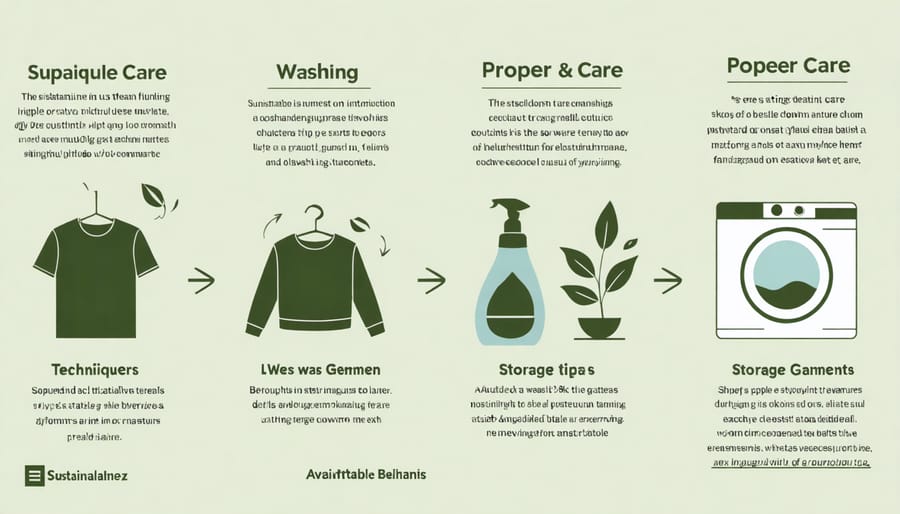
Gone are the days when sustainable fashion meant compromising on style or breaking the bank. As we’ve explored, there are now countless options for conscious consumers who want to look good while doing good. By supporting these sustainable brands, we’re not just building better wardrobes – we’re investing in the future of fashion and our planet. Whether you’re just starting your sustainable fashion journey or looking to expand your eco-friendly closet, remember that every purchase makes a difference. The brands we’ve discussed prove that fashion can be both trendy and responsible, making it easier than ever to align our style choices with our values. Let’s embrace this positive change in the fashion industry and continue to support brands that prioritize both people and planet.



